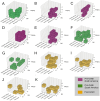New Miocene litoptern remains from Colombia and ecological structure of American Neogene herbivore guilds
- PMID: 40835954
- PMCID: PMC12366096
- DOI: 10.1186/s40850-025-00232-4
New Miocene litoptern remains from Colombia and ecological structure of American Neogene herbivore guilds
Abstract
Background: The Middle Miocene fauna of La Venta, Colombia, offers a grand opportunity to understand low-latitude South American ecosystems prior to the late Cenozoic Great American Biotic Interchange (GABI). We present new material of two proterotheriid litopterns, Villarroelia totoyoi and Mesolicaphrium sanalfonense, and a macraucheniid litoptern, Theosodon, from La Venta. During the GABI, North and South American faunas intermixed, after which some lineages proliferated and others died out. We conducted an ecomorphological analysis of 11 North and South American faunas pre-dating and post-dating the GABI by scoring all mid- to large-sized mammalian herbivores on their body size, tooth morphology, and feeding height.
Results: The fossils studied here offer new information on the deciduous dentition of M. sanalfonense and mandible of the La Venta Theosodon. Pre-GABI South American faunas were more ecomorphologically diverse than their North American counterparts. The post-GABI Pleistocene fauna exhibited similar ecomorphological diversity to pre-GABI South American faunas, but modern faunas show this diversity was mostly lost in the end-Pleistocene extinctions.
Conclusions: The new litoptern fossils provide previously unknown information on these species' morphology, but they do not resolve outstanding systematic and phylogenetic questions. Discrepancies in ecomorphological diversity between pre-GABI North and South American faunas is attributable to the presence of small, high-feeding (arboreal) taxa and hypselodont (ever-growing cheek teeth) taxa in South America, which North America lacked. Arboreal herbivores (porcupines and primates) experienced some success in North America after dispersing during the GABI. Although hypselodont xenarthrans were successful in post-GABI North America, the fact that most other hypselodont lineages went extinct during and after the GABI suggests that dental morphology may not fully capture the ecomorphological diversity in diet of North American herbivores. Future studies could examine faunas immediately before and after the GABI to uncover the precise dynamics of the interchange and why certain lineages succeeded while others failed.
Keywords: Colombia; Ecomorphology; La Venta; Litopterna; Miocene; Paleobiogeography; Paleobiology.
© 2025. The Author(s).
Conflict of interest statement
Declarations. Ethical approval: All fossil specimens described in this article were collected with all necessary permissions. Consent for publication: Not applicable. Competing interests: The authors declare that they have no competing interests.
Figures










References
-
- Carrillo JD. (ed.) Neotropical palaeontology: the Miocene La Venta biome/paléontologie néotropicale: le biome miocène de La Venta. Geodiversitas. 2023a;45,3,6,10,12,13,15,18,25,26.
-
- Carrillo JD, Jaramillo C, Abadía F, Aguilera O, Alfonso-Rojas A, Billet G, et al. The Miocene La Venta biome (Colombia): a century of research and future perspectives. Geodiversitas. 2023;45(26):739–67.
-
- Croft DA. Horned Armadillos and Rafting Monkeys: The Fascinating Fossil Mammals of South America. Bloomington, USA:Indiana University Press; 2016.
-
- Kay RF, Madden RH, Cifelli RL, Flynn JJ. Vertebrate Paleontology in the Neotropics: the Miocene Fauna of La Venta, Colombia. Washington, USA:Smithsonian University Press; 1997.
-
- Madden RH, Guerrero J, Kay RF, Flynn JJ, Swisher CC, Walton AH. The Laventan Age and Stage. Kay R, Madden RH, Cifelli RL, Flynn JJ, (editors). Vertebrate Paleontology in the Neotropics: the Miocene Fauna of La Venta. Colombia. Washington, USA:Smithsonian University Press; 1997. 499–519.
LinkOut - more resources
Full Text Sources

